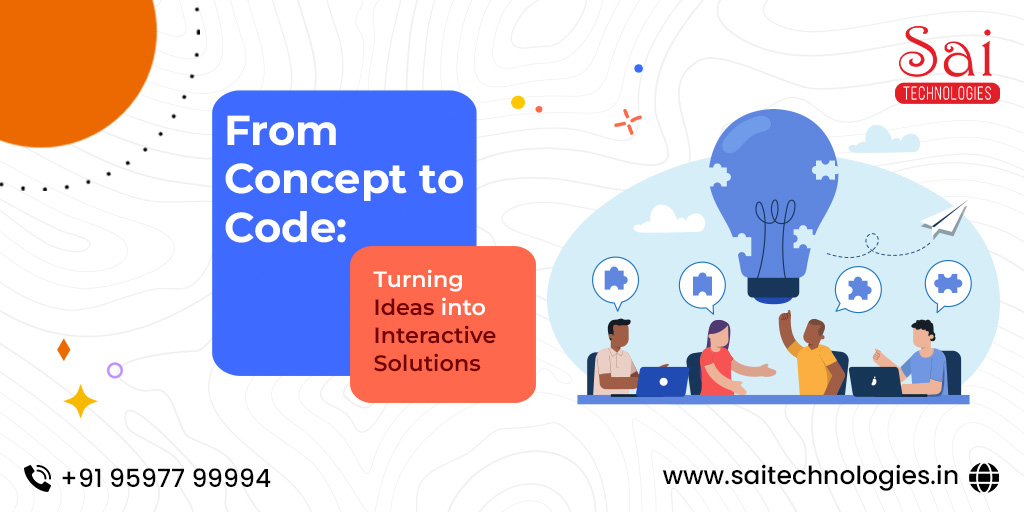From Concept to Code
Turning Ideas into Interactive Solutions

The journey from concept to code is the cornerstone of innovation and advancement in the ever-changing field of software development. This transformative process bridges the gap between abstract ideas and functional solutions, paving the way for technological advancements and user-centric experiences. From the initial spark of creativity to the meticulous crafting of code, this journey encompasses a myriad of stages, each contributing to the evolution of ideas into interactive realities. This blog explores the essential steps involved in this journey, highlighting the tools, methodologies, and best practices that empower developers to bring their visions to life.
Conceiving the Concept:
Every software solution begins with a concept—a vision of what could be. Whether it's addressing a specific need, solving a problem, or creating something entirely new, the first step is to define the concept clearly. This stage involves brainstorming, research, and ideation to flesh out the core ideas and objectives of the project.
Designing the Blueprint:
Once the concept is solidified, it's time to design the blueprint—the architectural foundation of the solution. This stage involves creating wireframes, mockups, and prototypes to visualize the user interface and user experience. Design principles, usability testing, and feedback loops help refine the blueprint into a comprehensive design plan.
Coding the Solution:
With the blueprint in hand, developers embark on the coding phase, where lines of code bring the concept to life. Using programming languages, frameworks, and libraries, developers translate design specifications into functional code. This iterative process involves writing, testing, and debugging code to ensure that it meets the project requirements and quality standards.
Iterating and Refining:
Software development is an iterative process, and as such, constant iteration and refinement are essential. Developers collaborate closely with stakeholders, incorporating feedback and making adjustments to the solution as needed. This iterative approach allows for flexibility and adaptability, ensuring that the final product aligns with the evolving needs and expectations of users.
Testing for Quality Assurance:
Quality assurance is integral to the software development lifecycle, ensuring that the solution meets predefined standards of functionality, usability, and performance. Testing methodologies such as unit testing, integration testing, and user acceptance testing are employed to identify and address any issues or bugs before deployment.
Deployment and Launch:
Once the solution has been thoroughly tested and refined, it's time for deployment and launch. This stage involves deploying the solution to production environments and making it available to end-users. Deployment strategies such as continuous integration/continuous deployment (CI/CD) help automate and streamline the deployment process, ensuring smooth and efficient rollout.
Gathering Feedback and Iterating:
Even after launch, the journey from concept to code continues as developers gather feedback from users and stakeholders. This feedback loop provides valuable insights into the usability, performance, and effectiveness of the solution, informing future iterations and enhancements.
Advanced Techniques and Technologies:
1. Microservices Architecture:
Explore the adoption of microservices architecture as an advanced concept in software development. Discuss how breaking down large, monolithic applications into smaller, independent services facilitates agility, scalability, and easier maintenance.
2. Containerization and Orchestration:
Introduce the concept of containerization using tools like Docker and container orchestration platforms like Kubernetes. Explain how containerization enables developers to package applications and dependencies into lightweight, portable containers, streamlining deployment and management.
3. Serverless Computing:
Delve into the serverless computing paradigm, where developers can build and run applications without managing servers. Discuss the benefits of serverless, such as automatic scaling, reduced operational overhead, and pay-per-use pricing models.
4. Artificial Intelligence and Machine Learning Integration:
Explore the integration of artificial intelligence (AI) and machine learning (ML) technologies into software solutions. Discuss how AI/ML algorithms can enhance user experiences through features like personalized recommendations, natural language processing, and predictive analytics.
5. Progressive Web Applications (PWAs):
Highlight the concept of progressive web applications (PWAs) as advanced web development techniques. Discuss how PWAs combine the best features of web and mobile applications, offering offline capabilities, push notifications, and fast performance.
6. Blockchain Integration:
Introduce blockchain technology as a disruptive force in software development. Discuss its applications beyond cryptocurrency, such as secure data storage, decentralized identity verification, and transparent transaction processing.
7. DevOps and Continuous Delivery:
Explore the principles of DevOps and continuous delivery (CD) as advanced methodologies for streamlining the software development lifecycle. Discuss how automation, collaboration, and feedback loops improve deployment frequency, reliability, and time-to-market.
8. Edge Computing:
Discuss the emerging trend of edge computing and its implications for interactive solutions. Explore how edge computing brings computation closer to the source of data generation, reducing latency and enabling real-time processing for interactive applications.
9. API-First Development:
Introduce the concept of API-first development, where developers design APIs before implementing the frontend or backend. Discuss the benefits of API-first approach, such as improved interoperability, flexibility, and reusability of code.
10. Augmented Reality (AR) and Virtual Reality (VR):
Explore the integration of augmented reality (AR) and virtual reality (VR) technologies into interactive solutions. Discuss how AR/VR experiences can enhance user engagement and immersion in various domains, such as gaming, education, and training.
Conclusion:
The journey from concept to code is a dynamic and iterative process that requires collaboration, creativity, and attention to detail. By following best practices and leveraging modern tools and technologies, developers can transform abstract ideas into interactive solutions that make a meaningful impact in the digital landscape. From conception to deployment and beyond, the journey from concept to code is a testament to the transformative power of software development.

